Occupational environment monitoring at the factory producing paint
99,000 ₫
Note: The above price is calculated for one sample. Prices may fluctuate depending on the area of the environment to be monitored and market conditions. For more accurate pricing support, please refer to the price list or contact our consulting staff directly.
Workplace environment monitoring for a paint manufacturing factory is a session of collecting, analyzing, and evaluating factors at the workplace that may be harmful to workers health.
Table of Contents
Toggle1. Overview of Paint Manufacturing Factories
a. What is a paint manufacturing factory?
A paint manufacturing factory is an industrial facility that produces paints and related products. These factories are capable of producing industrial paints, decorative paints, protective coatings, primers, and other types of paints for various applications.
Paint manufacturing factories are typically equipped with machinery and systems to produce paint from basic materials such as resins, solvents, hardeners, pigments, and other additives. The paint production process includes mixing components, processing, manufacturing, and packaging the final product.
These factories usually implement strict quality standards and procedures to ensure that the paints meet color, durability, protective properties, and other customer requirements.
The technology and production process may vary depending on the factory and type of paint produced. Paint manufacturing factories play a crucial role in supplying paint for industries, construction, decoration, and many other fields.

b. Production stages in paint manufacturing factories
Production stages in paint manufacturing factories may vary depending on each factory’s process and technology. However, the main stages typically include:
- Material preparation: In this stage, main ingredients such as pigments, film-formers, solvents, hardeners, additives, and auxiliary substances are prepared and measured according to specific ratios.
- Mixing and combining ingredients: Ingredients are mixed and combined according to a specific formula. The mixing process is performed using mixers or mixing systems to ensure uniformity and achieve the desired product quality.
- Cooking/Processing: In some cases, paint needs to undergo heating to achieve certain properties. This may include specific temperatures, pressures, and processing times to activate chemical reactions and create the desired molecular structure.
- Quality control: After production, paints are tested to ensure they meet standards and requirements. Tests may include viscosity, gloss, coverage, color durability, adhesion, and other properties.
- Packaging and bottling: Once the paints pass quality inspection, they are packaged in suitable containers and bottles. Packaging involves selecting appropriate containers, measuring, and preparing the product for transport and sale.
- Storage and transportation: Packaged paints are stored in warehouses and prepared for distribution to retailers and customers. During transportation, safety measures are taken to prevent damage or leakage.

c. Machinery used in paint manufacturing factories
Various types of machinery and equipment are used in paint manufacturing factories for production and related processes. Common machinery includes:
- Mixers: Used to mix paint ingredients. Mixers can be cylindrical, conical, or double-shaft types, ensuring uniform combination of paint components.
- Heating/Processing machines: Used for cooking paint, controlling temperature and time to activate chemical reactions and create desired molecular structure.
- Paint spraying machines: Used to apply paint onto surfaces. Types include electric spray guns, high-pressure spray machines, air spray, and gravity-feed sprayers, ensuring proper coverage and finish.
- Cutting and polishing machines: Used for cutting, polishing, and finishing painted surfaces. Can include belt cutters, saw blade cutters, automatic or handheld polishers.
- Quality testing machines: Used to test paint properties such as viscosity, gloss, adhesion, and color durability. Machines include viscometers, gloss meters, adhesion testers, and color measurement devices.

d. Occupational diseases in paint manufacturing factories
Workers in paint manufacturing factories may develop certain occupational diseases due to exposure to chemical compounds during paint production. Common occupational diseases include:
- Respiratory diseases: Exposure to volatile organic compounds from paints, solvents, and additives may cause chemical pneumonia, bronchitis, sinusitis, asthma, and pleural diseases.
- Skin diseases: Contact with chemicals may cause dermatitis, allergic reactions, eczema, and dryness or cracking of the skin.
- Cardiovascular diseases: Some chemicals, including VOCs and hardeners, may pose cardiovascular risks, leading to hypertension, arrhythmias, and vascular diseases.
- Nervous system disorders: Exposure to certain chemicals may result in dizziness, headaches, fatigue, memory loss, and nerve damage.
- Cancer: Certain compounds such as heavy metals, volatile organics, and film-forming agents may increase cancer risk, especially with prolonged exposure without adequate safety measures.

e. Common types of paint on the market
Common types of paint used in industry and decoration include:
- Water-based paint: Uses water as the main solvent. Eco-friendly, easy to clean, and low odor. Commonly used in interior and exterior decoration, available in many colors with high durability.
- Oil-based paint: Uses oil or oil-based solvents. Provides strong adhesion and durability, suitable for hard surfaces like metal, wood, and concrete. Has strong odor and longer drying time.
- Epoxy paint: Contains epoxy compounds. Excellent adhesion, hardness, chemical, and abrasion resistance. Commonly used on industrial floors, tanks, pipes, and metal surfaces.
- Alkyd paint: Based on alkyd resins combined with solvents and vegetable oils. High durability, weather resistance, and good adhesion. Often used on wood, metal, and plastic surfaces.
- Gloss paint: High gloss finish creating smooth, shiny surfaces. Used in interior decoration, including walls, doors, and window frames.
- Heat-resistant paint: Designed to withstand high temperatures. Used on surfaces near furnaces, heat pipes, molds, and other high-temperature industrial equipment.
2. Overview of occupational environment monitoring services
a. What is occupational environment monitoring at a paint manufacturing factory?
Occupational environment monitoring (or workplace environment measurement) at a paint manufacturing factory involves collecting, evaluating, and analyzing measurements of workplace environmental factors to implement timely measures, minimize environmental hazards to worker health, and prevent occupational diseases. It is a mandatory requirement for paint manufacturing factories.
Occupational environment monitoring is critical for protecting and improving worker health, as employees are the main resource generating profits. Workers exposed to risk factors above allowed limits may suffer health consequences and develop occupational diseases.
REGISTER FOR OCCUPATIONAL ENVIRONMENT MONITORING SERVICE
b. Nam Toan Viet’s occupational environment monitoring program
Nam Toan Viet’s occupational environment monitoring program is developed by engineers specializing in occupational safety and environmental protection. The program uses modern measurement methods to monitor air, water, microclimate, physical factors, and dust in the workplace. It plays a key role in ensuring a safe work environment and protecting employee health.
Additionally, Nam Toan Viet’s program helps research and develop solutions to improve workplace environmental quality. With a dedicated and professional team, this exclusive program represents a breakthrough in occupational safety and environmental management in Vietnam.

c. Standardization in workplace measurement procedures
Standardization in Nam Toan Viet’s measurement procedures ensures quality and reliability. The program follows recognized standards from the Ho Chi Minh City Department of Health, guaranteeing accurate and trustworthy data for evaluating workplace conditions and improving occupational safety.
These procedures also ensure measurements are performed by highly qualified monitoring professionals, allowing managers and experts to rely on Nam Toan Viet’s results for informed decisions.
By applying standardized procedures, Nam Toan Viet demonstrates its commitment to providing a safe work environment and contributing to the development of occupational safety and environmental management in Vietnam.
d. Reporting occupational environment monitoring results for paint factories
Monitoring results are prepared according to Form No. 04, Appendix III issued with Decree 44/2016/ND-CP and prepared in two copies: one sent to the contracting factory and one retained by the monitoring organization.
Records must be maintained indefinitely according to legal regulations.

e. Frequency of occupational environment monitoring as per law
According to Clause 2 of Article 18 of the Law on Occupational Safety and Hygiene 84/2015/QH13, employers must organize workplace environment monitoring at least once per year.
f. Deadlines for submitting monitoring results as per law
Reports must be submitted before December 31 each year. Enterprises must submit monitoring results to the local Department of Health at their headquarters and at the workplaces.
When production processes or technology change, or facilities are upgraded with new hazards, enterprises must update occupational hygiene records to include new harmful factors requiring monitoring.
g. Penalties for violations of occupational environment monitoring by employers
According to Article 27 of Decree 12/2022/ND-CP dated January 17, 2022:
- Clause 2: Fine of 2,000,000 – 5,000,000 VND for employers who fail to publicly disclose monitoring results to employees immediately after results are available.
- Clause 3: Fine of 20,000,000 – 40,000,000 VND for employers who fail to conduct occupational environment monitoring as required by law.
- Clause 4: Fine of 40,000,000 – 60,000,000 VND for employers who collaborate with monitoring organizations to commit fraud in monitoring activities, without reaching criminal liability.
3. Harmful environmental factors for workers in paint manufacturing factories
Workers in paint manufacturing factories may be exposed to several harmful environmental factors. The following are some potential hazards that could endanger workers’ health:
- Volatile organic vapors: Organic compounds in paint can evaporate and form volatile organic vapors in the factory air. Inhaling these vapors can cause respiratory irritation, itching, and difficulty breathing. Some organic compounds may also pose a cancer risk.
- Fine particles and dust: Handling raw materials and mixing during paint production can generate dust and fine particles. Long-term exposure to dust and fine particles may cause respiratory irritation, pneumonia, and other respiratory problems.
- Toxic chemicals: Paint contains additives and film-forming agents that may include toxic chemicals such as lead, mercury, hexavalent chromium, and other chemical substances. Exposure to these chemicals can harm the nervous system, cardiovascular system, and respiratory system.
- Ultraviolet (UV) light: During the drying and curing of paint, workers may be exposed to ultraviolet light from sources such as UV lamps. Prolonged exposure to UV light can cause skin burns, pigmentation, and negative effects on the eyes.
- Noise: Machinery and equipment in paint manufacturing factories may generate high noise levels. Long-term exposure to noise can lead to permanent hearing damage and issues such as hearing loss and tinnitus.
- Temperature and humidity: Paint production processes may cause fluctuations in temperature and humidity in the workplace. High temperatures and low humidity can cause discomfort, fatigue, and affect workers’ performance.
REGISTER FOR OCCUPATIONAL ENVIRONMENT MONITORING SERVICE
4. Measures to improve working conditions in paint manufacturing factories
Improving working conditions in paint manufacturing factories is crucial to ensure worker safety and health. The following measures can help improve the workplace environment:
- Ventilation and exhaust systems: Use ventilation and exhaust systems to create airflow throughout the factory. This helps remove volatile organic vapors and dust from paint production and minimizes workers’ exposure to harmful substances.
- Waste management: Ensure proper waste management procedures that comply with regulations, including collecting, treating, and recycling waste from paint production. Ensure that waste is stored and handled safely and appropriately.
- Training and education: Train and educate workers on risks and safety measures in the workplace. Workers should be instructed on how to use personal protective equipment, follow safe work procedures, and handle materials safely.
- Use of personal protective equipment (PPE): Ensure workers are provided with and properly use PPE such as masks, safety goggles, helmets, gloves, and protective clothing. PPE helps protect workers from direct contact with harmful substances and reduces the risk of injury.
- Air quality control: Implement air quality control systems such as air filters and air treatment equipment to remove volatile organic vapors and dust from the workspace. This helps improve air quality and reduces risks for workers.
- Follow safe work procedures: Apply safe work procedures, including chemical handling guidelines, machinery operation protocols, and fire prevention measures. Compliance with these procedures helps minimize accident risks and protects worker health.
- Periodic inspection and maintenance: Conduct regular inspections and maintenance of equipment, machinery, and systems in paint manufacturing factories. This ensures efficient and safe operation and reduces the risk of accidents and malfunctions.
- Periodically conduct occupational environment monitoring in factories, collect and analyze harmful factors affecting workers, and implement adjustments to reduce hazards and prevent occupational diseases.
5. Benefits of periodic monitoring in paint manufacturing factories
An Toan Nam Viet provides businesses with significant advantages when using occupational environment monitoring services in accordance with Decree 44/2016/ND-CP on the management and control of harmful workplace factors affecting employees.
- Businesses can proactively control harmful factors in workshops or factories.
- Receive advice and recommendations on measures to minimize harmful factors and improve workplace environment quality.
- Indirectly protect human resources, a key factor in business development.
- Reduce the harmful impact of occupational diseases on health, thereby minimizing future treatment costs.
- Improve worker health, ensuring product quality and maintaining production output.
- Ensure compliance with labor safety laws and avoid legal risks.
- Enhance credibility and professionalism in all aspects, elevating the company’s brand.
Nam Viet’s environmental monitoring service is a solution to reduce occupational disease risks, contributing to a clean and high-quality working environment.

6. National occupational environment monitoring center
Occupational environment monitoring center of Nam Viet is a professional unit specializing in monitoring and measuring workplace environmental quality across all provinces in Vietnam. With a team of experienced monitoring specialists, the center uses modern measurement equipment to ensure accuracy and reliability.
In addition to monitoring services, the center assists clients in planning, managing, and tracking occupational environmental issues. With the motto “customer-centered,” the center prioritizes customer satisfaction, meets all client needs, and is committed to providing the best solutions for businesses.
REGISTER FOR OCCUPATIONAL ENVIRONMENT MONITORING SERVICE
With investments in technology, equipment, and human resources, Nam Viet’s monitoring center has become one of the most reputable units in occupational environment monitoring in Ho Chi Minh City, with the following objectives:
- We always value our brand reputation and the quality of our services.
- We provide clients with the best and most suitable solutions possible.
- Alongside a team of experienced Masters and Engineers, committed to environmental protection and business benefits.
- At Nam Viet Environmental Monitoring, companies receive professional service from experts in the monitoring field, along with the best cost advantages.
The occupational environment monitoring process at Nam Viet includes the following basic steps:
- Before conducting monitoring, our company ensures all equipment is calibrated according to legal regulations.
- Follow the occupational environment monitoring procedures committed to the Department of Health accurately and fully.
- Report monitoring results honestly to employers.
- If monitoring results indicate unsafe conditions, Nam Viet provides corrective solutions, and the workplace implements the following:
- Implement measures to improve working conditions, minimize harmful factor impacts, and prevent occupational diseases.
- Conduct health examinations to detect occupational and related diseases early for workers in unsafe environments.
- Provide in-kind compensation to workers according to labor law.

7. Occupational environment monitoring quotation
To help businesses conduct professional and effective occupational environment monitoring, Nam Viet provides clients with a quotation for occupational environment monitoring services that is high-quality and reasonably priced.
- Our quotation provides detailed pricing information for the monitoring services we offer, including costs related to travel, measurement, analysis, and reporting. Clients can trust the accuracy and reliability of the monitoring reports we provide.
- We commit to offering competitive and reasonable prices in the market and are always ready to provide quick and professional advice for any inquiries regarding monitoring services.
- With Nam Viet’s monitoring quotation, clients can easily select service packages suitable to their needs. We are committed to delivering the highest satisfaction with professional service quality.
No comments yet

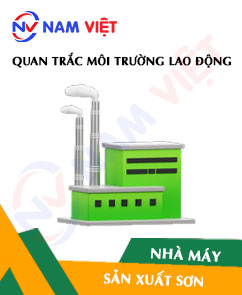
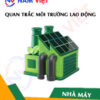
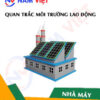





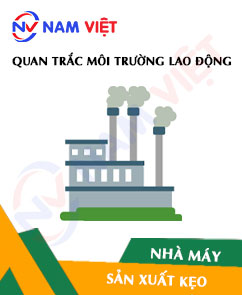
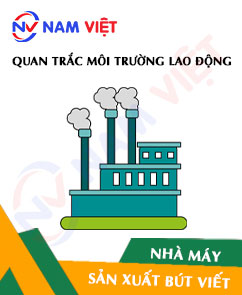
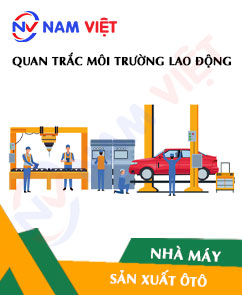
Review Occupational environment monitoring at the factory producing paint
There are no reviews yet.